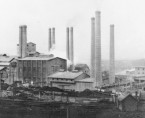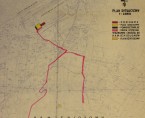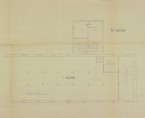Golleschau
A sub-camp in Goleszów (German: Golleschau), near Cieszyn. It was located on the grounds of a quarry and cement factory belonging to the SS-owned company Golleschauer Portland-Zemment AG. Opened at the turn of July/August 1942, it was one of the first Auschwitz sub-camps. It held an average of 400 to 500 prisoners, mostly Jews with several score of Germans, Poles, and “Jewish Mischlinge.” Only in the spring of 1944, after another group of Polish, Czech, and Hungarian Jews were brought in, did the sub-camp population exceed one thousand. The prisoners lived in a two-story building adjoining to the factory, with the roll-call square and the barracks for SS guards nearby.
The work required great physical effort—laying train tracks, breaking stones, sifting coal, packing cement in sacks, and stoking the kilns for burning lime. The Kommandos working in the quarries belonging to the cement plant, where they loaded rocks onto train cars, had it worst. Factory management estimated that “five Jews should load three cars in the course of one shift.”
Of the 2,348 prisoners noted in the sub-camp record book, almost 130 died, were shot, or committed suicide, while more than 1,200 were sent to Birkenau and Monowitz as unfit for work. The commandants of Golleschau were, respectively, SS-Oberscharführers Erich Picklapp, Hans Mirbeth, and Horst Czerwiński, with 51 SS men to assist them. In January 1945, the sub-camp was evacuated to Wodzisław Śląski, and from there to Sachsenhausen and Flossenbürg.


